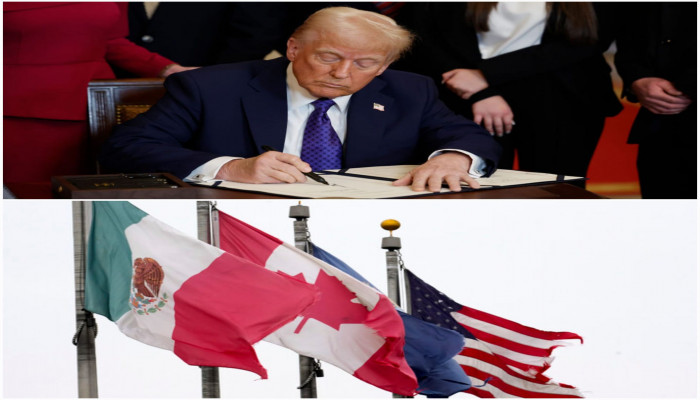Trump freezes tariffs on Mexico and Canada, keeps pressure on China
- In Reports
- 12:55 PM, Feb 04, 2025
- Myind Staff
On Monday, President Trump temporarily called off his threat to impose steep tariffs on Mexico and Canada. Instead, he has agreed to a 30-day pause, giving the two countries time to work on border security and crime enforcement. However, the tariffs on China are still set to kick in soon.
In response to President Trump's demands to tackle immigration and drug smuggling, Canadian Prime Minister Justin Trudeau and Mexican President Claudia Sheinbaum have agreed to strengthen border security. This agreement means that the 25% tariffs on Mexico and Canada, initially set to take effect today, will be put on hold for 30 days.
Canada has pledged to implement advanced technology and deploy additional personnel along its border with the United States. It has also committed to collaborating on efforts to combat organised crime, fentanyl trafficking and money laundering.
Meanwhile, Mexico has agreed to strengthen security along its northern border by deploying 10,000 National Guard troops to curb illegal migration and drug smuggling.
Additionally, the United States has made a commitment to preventing the flow of high-powered weapons into Mexico, according to Sheinbaum.
Trump on social media said, “As President, it is my responsibility to ensure the safety of ALL Americans, and I am doing just that. I am very pleased with this initial outcome”.
These agreements, at least for the time being, prevent a trade war that economists warned would harm the economies of all parties involved and lead to higher consumer prices. After speaking with the leaders of Canada and Mexico, President Trump announced plans to renegotiate economic agreements with these two crucial trading partners over the next month. The US, Canada and Mexico economies have become increasingly interconnected since the groundbreaking free-trade deal in the 1990s.
China has not received any exemptions from tariffs, which are set at 10% across all sectors and scheduled to take effect at 12:01 a.m. ET on Tuesday (0501 GMT). According to a White House spokesperson, U.S. President Donald Trump is not expected to speak with Chinese President Xi Jinping until later in the week.
Trump cautioned that he might impose even higher tariffs on China.
“China hopefully is going to stop sending us fentanyl, and if they’re not, the tariffs are going to go substantially higher,” he stated.
Beijing has responded by asserting that fentanyl is an issue for the United States to address and has announced its intention to challenge the tariffs at the World Trade Organisation. Additionally, China has threatened to implement countermeasures but has also indicated a willingness to engage in discussions.
The latest developments in the trade dispute led to a sharp rise in the Canadian dollar, which had previously hit its lowest point in over two decades. The news also boosted U.S. stock index futures following a day of declines on Wall Street. Meanwhile, industry groups concerned about supply chain disruptions expressed relief over the temporary pause in tariffs for other countries.
“That’s very encouraging news,” the head of a trade group of Canadian canola producers, Chris Davison, said. “We have a highly integrated industry that benefits both countries.”
On Sunday, former U.S. President Donald Trump indicated that the 27-member European Union could be the next focus of his trade policies. However, he did not specify a timeline for any potential actions.
During an informal summit in Brussels on Monday, EU leaders acknowledged the possibility of U.S. tariffs and warned that Europe would respond if such measures were imposed. However, they also emphasised the importance of dialogue and a reasonable approach to resolving trade disputes. The EU and the U.S. share a strong economic relationship, with the U.S. being Europe's most extensive trade and investment partner.
Meanwhile, Trump suggested that Britain, which officially exited the EU in 2020, might not be subject to the same tariff policies.
Over the weekend, Trump admitted that his tariffs might lead to "some short-term pain" for American consumers. However, he defended them as necessary measures to control immigration, combat narcotics trafficking and boost domestic industries.
According to ING analysts, the proposed tariffs would have impacted nearly half of all U.S. imports. The United States would need to more than double its manufacturing output to compensate for this, which would be an unrealistic goal shortly.
Meanwhile, other analysts have warned that these tariffs could push Canada and Mexico into a recession. They also cautioned that the U.S. economy might experience “stagflation,” a scenario characterised by high inflation, sluggish economic growth, and rising unemployment.







Comments